Marketing Research Strategies: Ideas and Approaches to Conducting Research for Marketing Purposes
 In business and marketing, there is one rule that you need to learn: change is constant. From trends to market conditions, everything is dynamic.
If you want to succeed, you need to be able to adapt to the changing environment. That’s why it’s important to invest in marketing research. It’s a helpful way to identify the latest trends and make smarter decisions based on what’s working.
Would you buy an expensive gadget without reading up on it properly? Would you skip out on researching about its competitors?
No, right?
That’s exactly the rationale behind the concept of marketing research: making informed decisions, you need to back them up with data.
Not sure how to take more data-driven decisions?
In this post, we’ll discuss different strategies that businesses — both big and small — can use for marketing research.
In business and marketing, there is one rule that you need to learn: change is constant. From trends to market conditions, everything is dynamic.
If you want to succeed, you need to be able to adapt to the changing environment. That’s why it’s important to invest in marketing research. It’s a helpful way to identify the latest trends and make smarter decisions based on what’s working.
Would you buy an expensive gadget without reading up on it properly? Would you skip out on researching about its competitors?
No, right?
That’s exactly the rationale behind the concept of marketing research: making informed decisions, you need to back them up with data.
Not sure how to take more data-driven decisions?
In this post, we’ll discuss different strategies that businesses — both big and small — can use for marketing research.
Marketing research strategies: ideas and approaches to conducting research for marketing purposes.
Click To TweetWhat Exactly is Marketing Research and Why is It Important?
Marketing research isn’t just about searching up the latest industry trends on Google. It’s a detailed process that will require your dedication, time, and effort. Simply put, it is the process of collecting information about your target audience and their preferences. By digging deeper, your aim should be to determine if your service or product is likely to meet their needs. It’s evident that marketing research has a lot of advantages.
Regardless of the industry you’re in, it’s a tactic that can help you optimize your marketing efforts and create more effective campaigns.
It’s evident that marketing research has a lot of advantages.
Regardless of the industry you’re in, it’s a tactic that can help you optimize your marketing efforts and create more effective campaigns.
How to Get Started With Marketing Research: A Quick Guide
Want to get started with marketing research? Here is a quick roadmap that you can use to make sure you don’t miss out on anything important.1. Define Your Purpose
Before you get started, you need to be clear about your purpose. Define a problem in which you are trying to find a solution. Once you define the problem, you’ll have a better idea of the kind of data that you’ll need to find. Find out answers to the following questions:- What’s the scope of the research?
- What’s the kind of data that you need for your research?
- Which business decisions will be based on your research findings?
- Which variables should you be investigating?
2. Create a Research Plan
Once you have found the problem you want to solve, the next step is to start building a research plan. If you haven’t developed a marketing research plan before, the task can be intimidating. To help you out, here are some approaches you can use for your research.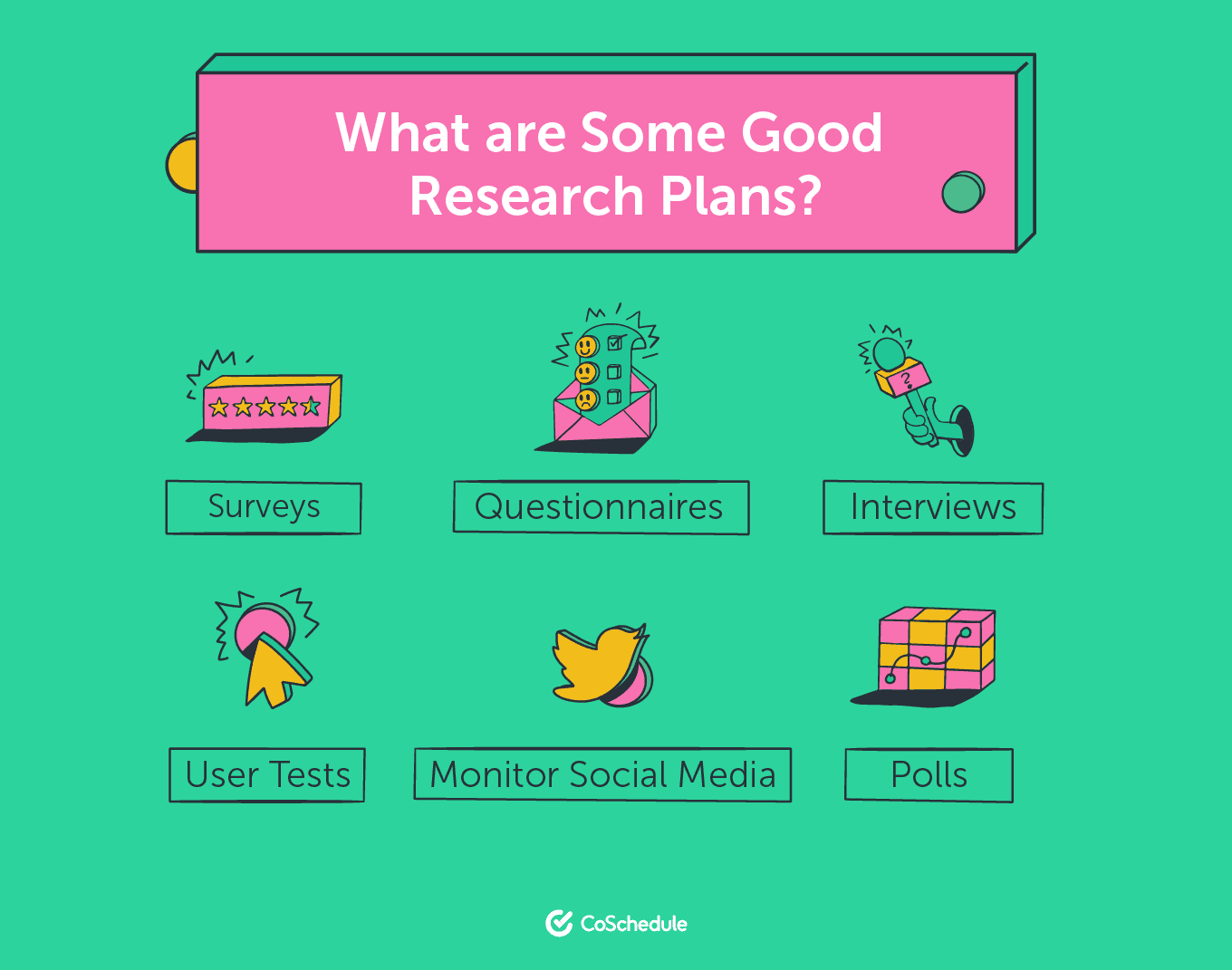
Surveys and Interviews
Create a survey that includes relevant questions based on the purpose of your research. You can ask open-ended questions or opt for multiple-choice questions. Alternatively, you can also opt for interviews. Just keep in mind that your target audience’s time is precious; if your survey is too lengthy, they may leave it unfilled. That’s why it’s important to be concise with your surveys.Create a survey that includes relevant questions based on the purpose of your research.
Click To Tweet- Questions related to demography: Begin by asking demographic questions, including age, gender, income, location, etc.
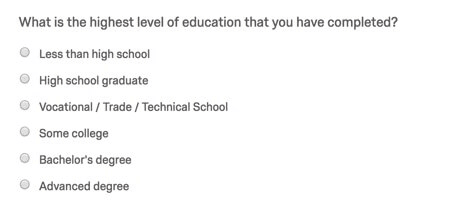 Image via Qualtrics
Image via Qualtrics
- Questions related to behavior: Follow them up with behavioral questions that give you an insight into a person’s lifestyle. For instance, if your product is an app, you could ask questions about their phone usage.
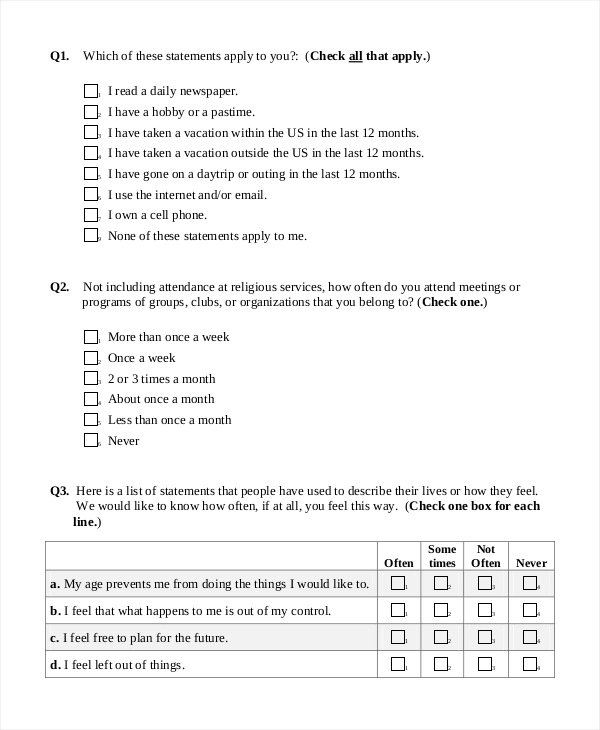 Image via Examples
Image via Examples
- Questions related to similar products: To gauge demand, you can ask users if they use products from your competitors. It’s a smart way to get started with competitive analysis as well. Also, ask them about how long they have been using it, and what they like or don’t like about it.
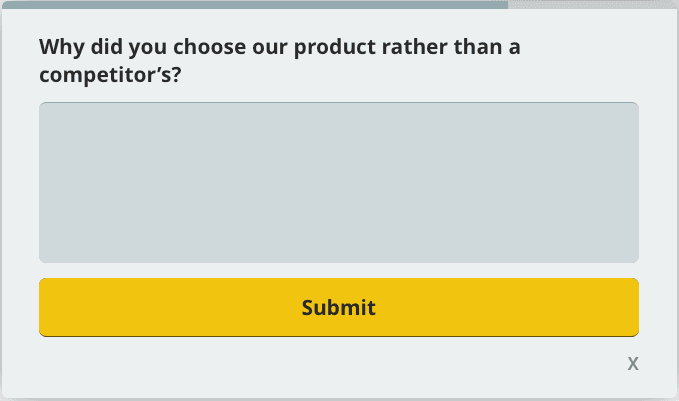 Image via Survicate
Image via Survicate
- Questions related to your product or concept: To validate your idea and get feedback, describe your product and its key features concisely. Ask them whether they would be interested in using such a product and why.
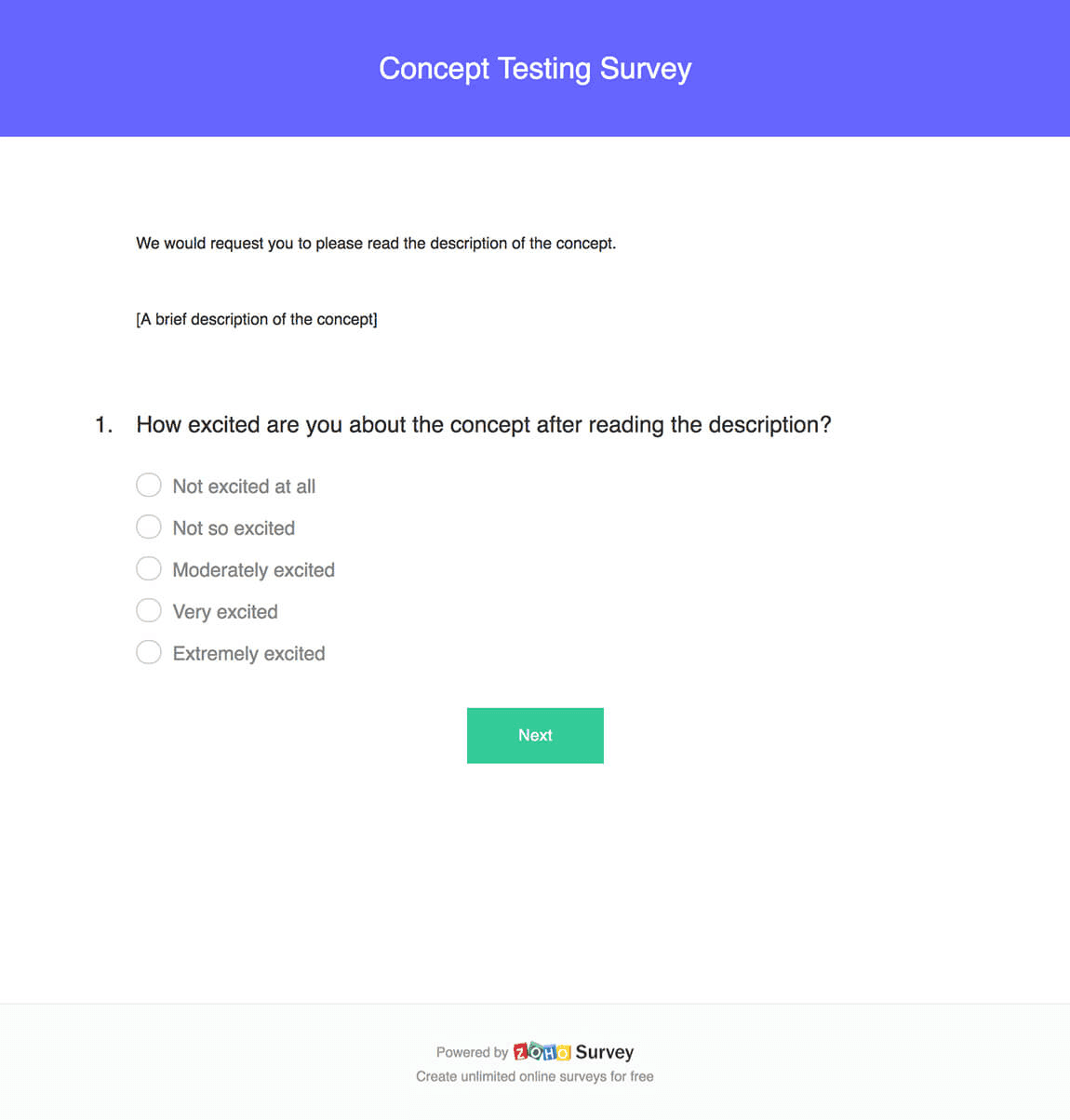 Image via Zoho
Image via Zoho
- Questions related to price points: To gauge the user’s willingness to pay, ask them questions related to the price point of your product.
 Image via Qualtrics
Pro Tip: You can use tools, like SurveyMonkey, TypeForm, SurveySparrow, etc., to create engaging, online surveys.
Image via Qualtrics
Pro Tip: You can use tools, like SurveyMonkey, TypeForm, SurveySparrow, etc., to create engaging, online surveys.
User Tests
Another way to gauge the pulse of your target audience is to analyze website data. This way, you can figure out their preferences without actually having to ask them any questions. With the help of A/B tests, you can also find out which website elements your users are interacting with the most. Based on the results, you can tell whether your website design and messaging is resonating with your audience or not. Pro Tip: Use tools, like Hotjar, Lucky Orange, etc., along with Google Analytics to track how your users interact with your site.3. Look at Other Case Studies
What if someone else has already solved a problem that you’re facing? Looking at their strategy can help you find a way out as well. Look at other business’s case studies and marketing strategies to broaden your perspective and learning. While primary data is the best, even secondary data can help you with market research.
Invest some time in studying the business models of other companies in your niche. Read up on case studies to get a better idea of solutions that you can try out yourself. If you can find the right case study, it can considerably cut down on the time you invest in research.
Look at other business’s case studies and marketing strategies to broaden your perspective and learning. While primary data is the best, even secondary data can help you with market research.
Invest some time in studying the business models of other companies in your niche. Read up on case studies to get a better idea of solutions that you can try out yourself. If you can find the right case study, it can considerably cut down on the time you invest in research.
Read up on case studies to get a better idea of solutions that you can try out yourself.
Click To Tweet4. Identify the Personas for Your Research
You know the purpose of your research, and you have a plan in place. What’s next? You need to find people who can participate in market research. Ideally, they should have characteristics similar to your buyer personas. Their issues and buying habits should also be similar. If you have multiple user personas, you can also recruit different sample groups for each of these personas. In addition to this, you can reach out to people who may have interacted with your brand recently. It’s also a good idea to include people in your research who may have opted to make a purchase from your competitors, or the ones who may not have purchased at all. For added diversity, you can also add focus on people who have made a recent purchase. To get a balanced perspective, it is advisable to aim for a good mix of participants for your market research. To get more participation, you can call out for participants on your social media channels or send emails to your subscribers. It’s also a good idea to offer them an incentive for taking your survey. When you offer something in return for their efforts, users are more likely to participate willingly. Not sure how to go about it? Take inspiration from the email created by King Arthur Flour to promote their survey. In exchange for the time that participants invest in taking the survey, they can get a $10 discount on their next order.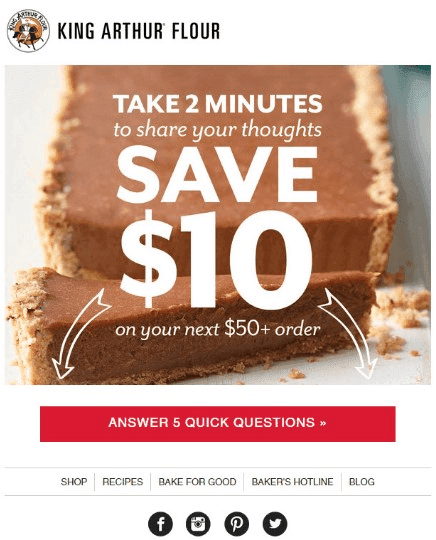 Image via Essenceofemail
Image via Essenceofemail
5. Leverage Social Media Listening
Another way to find out what users are talking about is to listen in on their social media conversations. Social media listening is a cost-effective tactic that can give you invaluable insights. Go to Facebook, Twitter, Instagram, Reddit, and other social media channels to check what users are saying about your brand and products. Pay special attention to complaints and negative feedback; it can help you find areas of improvement. What’s more, you can even get ideas for new features or services based on what users say is lacking in your product. For instance, Starbucks leveraged social media listening to come up with new items on their menu. In fact, they launched a separate Twitter handle, “My Starbucks Idea”, to encourage customers to vote for the new ideas they were launching. It’s a smart way to find the pulse of the audience and get more engagement. Image via Twitter
Not just that, you can leverage social media listening tools to also find out what users are saying about your competitors. It’s also a good idea to check out review websites and find honest customer reviews.
Pro Tip: Try to use specific keywords related to your industry and brand on social media channels. This way, you can get candid insights from the audience.
Image via Twitter
Not just that, you can leverage social media listening tools to also find out what users are saying about your competitors. It’s also a good idea to check out review websites and find honest customer reviews.
Pro Tip: Try to use specific keywords related to your industry and brand on social media channels. This way, you can get candid insights from the audience.
6. Leverage Polls on Social Media
Social media is abuzz with activity at any given point of time. You’ll find people discussing the most mundane things, at length, on Reddit and Twitter. Whereas it’s difficult to convince users to participate in a survey otherwise, people are more than willing to share their opinion on social media channels. What’s more, Facebook, Instagram, Twitter, and other platforms have features that make it easier to take a quick survey. The best part is that creating polls on these platforms is not at all time-consuming, and it boosts your overall engagement rate. Even for the audience, it doesn’t take more than a few seconds to send in their responses. Such interactive content is quick, fun, and engaging. It’s a win-win! Take a look at how Taco Bell leverages the polls feature on Twitter to compare the popularity of their Doritos flavors.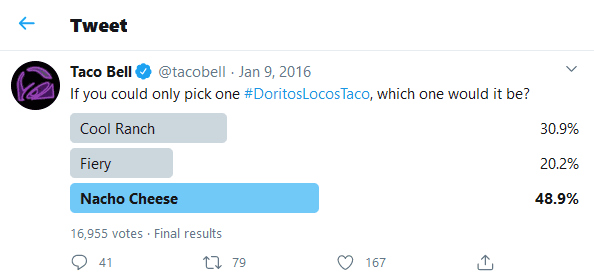 Image via Twitter
Image via Twitter
7. Analyze Your Data
We’ve discussed multiple methods for data collection. Pick the one that suits you and collect all the required data, but raw data doesn’t help anyone. You have to analyze the data to make some sense out of it — look for patterns that can lead to conclusions. For that, you’ll first need to organize your data. Put it all out in a spreadsheet and structure it well. Once that is done, use advanced features to find trends in the data. It’s also important to segment your results to get a clearer picture of the overall trends. What’s more, you need to focus on visualizing your data via graphs, charts, and more. This way, you can create insightful marketing reports. Keep in mind that your results should be aligned with your objective and should answer the questions that you had at the onset.Your research results should be aligned with your objective and answer all the right questions.
Click To Tweet

